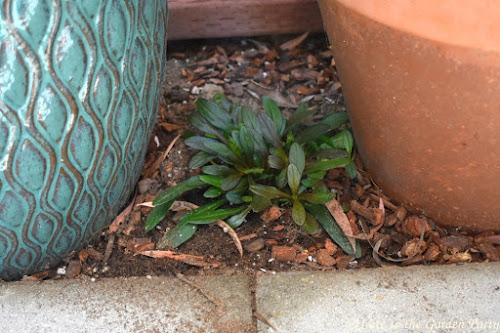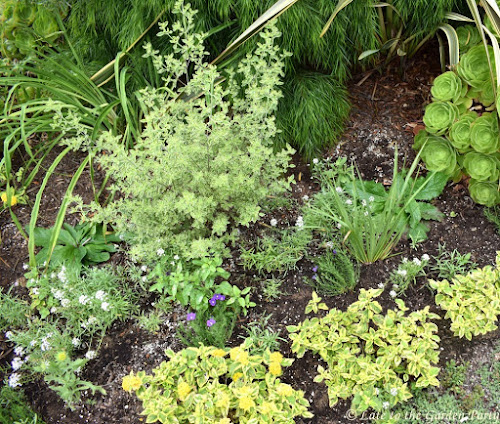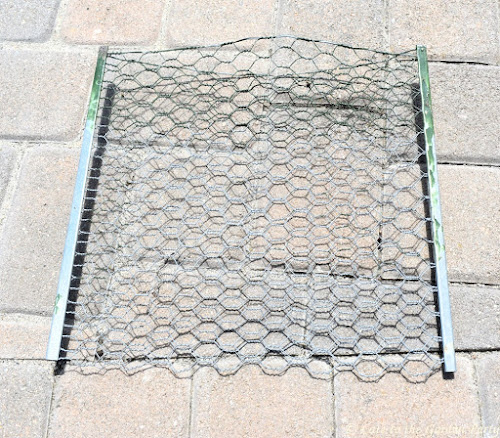I made a reservation to visit
South Coast Botanic Garden again this week, prompted mostly by curiosity over the progress of the Dahlia Garden. I collaborated with two other docents and the then head gardener on restoring that area earlier this year. We'd prepared the beds, ordered the tubers, and agreed on a layout before all volunteers were furloughed in March and the head gardener transferred to another LA County garden. We handed everything over to other members of SCBG's paid staff and that was that. During my
June visit, I noticed that approximately half the tubers had sprouted but there were no blooms yet; however, recent newsletters sent to members revealed that some blooms have since appeared.
 |
This is a view of the three raised planters that make up the Dahlia Garden. I didn't manage to get a good shot of the semi-circular bed on the right (west side) so I've shown separate front and rear shots of the bed, regrettably shot from different angles. The rear half of that bed apparently was never planted.
|
But let's focus on the pretty flowers. We'll start with the plants in bloom in the left (east side) bed.
 |
This is 'Totally Tangerine', an anemone-type dahlia
|
 |
'Lifestyle' (not labeled by the garden) is another anemone-type dahlia. I expected the flower to be more yellow than lavender-pink so it doesn't blend as well with its neighbors as I'd hoped when we created our plan.
|
 |
'My Little Sunshine', a so-called cactus-type dahlia
|
 |
This is 'Cafe au Lait', currently very popular in dahlia circles
|
 |
'Bahama Mama' is in the decorative class, which frankly seems to be a type that encompasses a lot of dahlias that aren't easily classified in another category. Unfortunately, this one was past its prime.
|
 |
'Penhill Dark Monarch' may be the most flamboyant of the group currently in bloom. It's one of many included in the Dahlia Garden described as a "dinnerplate dahlia." That description isn't actually a dahlia "type" but refers generally to the large size of the blooms.
|
Only two of the plants in the central bed were blooming and many still seem to be no-shows.
 |
'Magic Moment', a cactus-type with incurved petals
|
 |
I believe this is 'Lisa Lisa', mistakenly labeled as 'Einstein', which has a deep purple color and larger flowers
|
The semi-circular bed on the right (west side) wasn't completely planted for some reason. With the volunteers gone, I suspect the shortage of garden help left the paid staff seriously stretched in addressing the needs of the 87 acre botanic garden and the ball on this project just got dropped. A gardener I spoke to during my visit on Wednesday morning told me that some of the tubers had been planted in pots, which are currently in the greenhouse. Here's what was blooming among the plants in the ground:
 |
'Kelvin Floodlight', a dinner plate dahlia in the decorative group. This one stands out for both the flower's size and nearly florescent color.
|
 |
In contrast, 'Cherry Drop' (which was also unlabeled) has a more diminutive flower. It's classified as a waterlily-type dahlia.
|
 |
Pom-pom type dahlias aren't among my personal favorites but 'Kasasagi' is an excellent example
|
 |
This was mislabeled as 'Ginger Snap', which is a collarette type dahlia. I believe it's actually 'Crazy Legs', a decorative dahlia with similarly sized flowers.
|
Because our planning group wanted to show the visiting public the wide variety of flower shapes, sizes, and colors available within the genus, the layout of the dahlia beds was a dicey proposition. Our layout called for a zig-zag line-up based on gradations of color and size. With many plants still no-shows, the rainbow effect we sought to create hasn't been realized, at least not yet, and the range of flower shapes isn't represented in the breadth we'd planned due to the number of plants still missing. Plants grow at different rates and their mature sizes are subject to variation, which also complicates the planned symmetry of the beds.
Oh well, the handful of people I spoke to during my brief visit seemed to enjoy the flowers. I think the informational posters we'd originally planned would still be helpful as I encountered a few people who'd guessed the flowers were chrysanthemums!
My own dahlias, which were planted MUCH later than last year's crop, are slowly budding out. Hopefully, I'll have at least a few flowers soon.
 |
'Sellwood Glory' seems intent on leading the parade in my own garden
|
I only spent an hour in total at the botanic garden. Even though I arrived earlier this time, it was more crowded than it was during my prior visit. It wasn't a problem to maintain social distancing and, with the exception of some small children, visitors and staff were all wearing masks but I felt on edge anyway. However, I did cover a few other areas of the garden before I left.
 |
The Mexican sunflower tree (Tithonia diversifolia) has fully fleshed out and was covered in blooms. The heaviest concentration of flowers was on the tree's west side but that angle didn't photograph as well as this one.
|
 |
The seating area between the Vegetable Garden and the Living Wall was looking good
|
 |
Backlit cactus in the Desert Garden
|
 |
Grapevine-covered bench in the Garden for the Senses
|
 |
The flowers in the lavender field were fading but the area still looked good
|
 |
The Brazilian orchid tree (Bauhinia forficata) in bloom
|
 |
A bright pink-flowered Callistemon in lieu of the usual red version
|
That's it for me this week. I hope you enjoy a pleasant weekend!
All material © 2012-2020 by Kris Peterson for Late to the Garden Party






















































